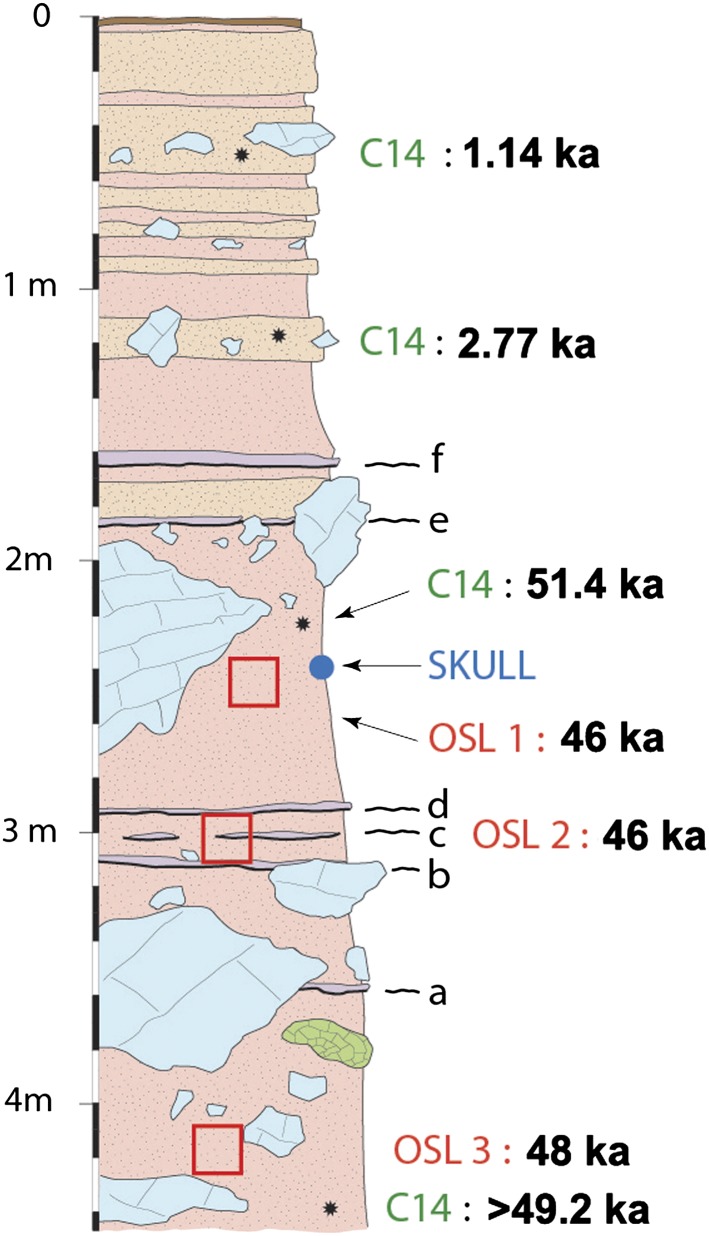We recently presented a human fossil from Tam Pa Ling (TPL), Laos (i.e., TPL1), that is the earliest definitively modern human fossil in eastern Asia (1). Unfounded criticism of this research, showing partial readings of this publication, has been raised by Pierret et al. (2). They allege that (i) the chronology is not stratigraphically consistent, (ii) TPL1 was an intrusive burial, and (iii) other human fossils in Asia are older.
They question the validity of the dating because of an apparent “reverse stratigraphy” (Fig. 1), whereby “older” dates are located higher in the section [i.e., 51.4 (14C) at 2.1 m] and “younger” dates are at the bottom of the section [i.e., 48 ka (optically stimulated luminescence [OSL]) and >49.2 ka (14C) at 4.3 m] (2). This criticism ignores the presented SEs (table 2 and table S1 in ref. 1), which make the results statistically equivalent (Table 1). More importantly, they ignore that the radiocarbon results are well beyond the accepted radiocarbon barrier of ∼40 ka (3), indicating that the charcoal has a minimum age of ∼40 ka. Bearing in mind these problems, we have conservatively estimated the burial age to be ∼46 ka according to the luminescence dating of the sediments. As the luminescence results are stratigraphically consistent, we perceive no irreconcilable differences between the stratigraphy and dating.
Fig. 1.
The 4-m stratigraphic section from TPL. Provenance of the charcoals sampled for 14C dating and soil sampled for OSL dating are identified on stratigraphy. TPL1 was found at a depth of 2.35 m.
Table 1.
Age estimates and SEs for TPL radiocarbon, OSL, and U-series samples
| Sample | Dating method | Depth, m | Age, y | SE, y | CI, y |
| TPL b | 14C | 2.1 | 51,400 | ±3,300 | 48,100–54,700 |
| TPL1 | OSL | 2.35–2.55 | 46,000 | ±4,000 | 42,000–50,000 |
| TPL2 | OSL | 3.15–3.35 | 46,000 | ±5,000 | 41,000–51,000 |
| TPL 09–3 | 14C | 4.3 | >49,200 | — | >49,200 |
| TPL 3 | OSL | 4.2–4.4 | 48,000 | ±5,000 | 43,000–53,000 |
| TPL1 (L29) | U/Th | 2.35 | 63,600 | ±6,000 | 57,600–69,600 |
A second issue they raise (2) is that TPL1 is an intrusive burial, as it is older (63.6 ka U/Th on bone) than the surrounding sediments (Fig. 1). The fossil should, however, be of greater antiquity given that this is not an in situ burial site. Instead, there is an unknown period during which the fossil was outside before being washed into the cave; thus, the age of the sediment burial is younger than the age of the associated fossil remains. Furthermore, the U/Th dating of bone represents a maximum age as a result of an unknown model of Uranium uptake.
Finally, we interpret TPL1 as the earliest human fossil that is both well-dated and fully modern in morphology. Zhirendong demonstrates a mixture of archaic and modern traits, making it significant but not fully modern in appearance (4). Similarly, the metatarsal from Callao Cave is only diagnostic to the genus Homo given that it falls within “the morphological and size ranges of Homo habilis and H. floresiensis” (ref. 5, p. 123). Although the modernity of the Liujiang fossil is not questioned, it has no direct date and no secure stratigraphic provenance. It has been variably dated to ca. 20 ka, ca. 67 ka, 111 to 139 ka, and >153 ka (6), and this uncertain stratigraphic context has prevented many scholars from accepting any of the dates currently attributed to it (6). We agree on the importance of multidisciplinary work to continue the growing body of research on the Asian fossil record. Well-documented and well-dated fossils like TPL1 with a solid stratigraphic context are integral to this process.
Footnotes
The authors declare no conflict of interest.
References
- 1.Demeter F, et al. Anatomically modern human in Southeast Asia (Laos) by 46 ka. Proc Natl Acad Sci USA. 2012;109(36):14375–14380. doi: 10.1073/pnas.1208104109. [DOI] [PMC free article] [PubMed] [Google Scholar]
- 2.Pierret A, Zeitoun V, Forestier H. Irreconcilable differences between stratigraphy and direct dating cast doubts upon the status of Tam Pa Ling fossil. Proc Natl Acad Sci USA. 2012;109:E3523. doi: 10.1073/pnas.1216774109. [DOI] [PMC free article] [PubMed] [Google Scholar]
- 3.Roberts RG, Jones R, Smith MA. Beyond the radiocarbon barrier in Australian prehistory. Antiquity. 1994;68:611–616. [Google Scholar]
- 4.Liu W, et al. Human remains from Zhirendong, South China, and modern human emergence in East Asia. Proc Natl Acad Sci USA. 2010;107(45):19201–19206. doi: 10.1073/pnas.1014386107. [DOI] [PMC free article] [PubMed] [Google Scholar]
- 5.Mijares AS, et al. New evidence for a 67,000-year-old human presence at Callao Cave, Luzon, Philippines. J Hum Evol. 2010;59(1):123–132. doi: 10.1016/j.jhevol.2010.04.008. [DOI] [PubMed] [Google Scholar]
- 6.Keates SG. The chronology of Pleistocene modern humans in China, Korea, and Japan. Radiocarbon. 2010;52(2-3):428–465. [Google Scholar]



